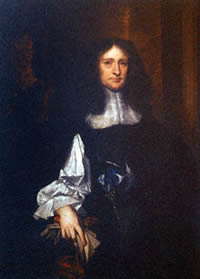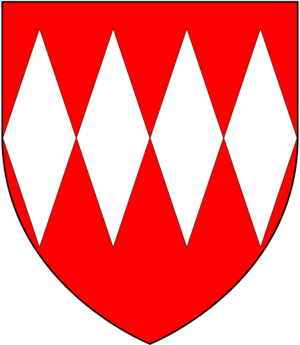George Carteret facts for kids
Quick facts for kids
Vice-Admiral
Sir George Carteret
|
|
|---|---|

Sir George Carteret
|
|
| Born | c. 1610 St Peter, Jersey |
| Died | 14 January 1680 |
| Allegiance | |
| Service/ |
|
| Rank | Vice-Admiral |
| Commands held | Treasurer of the Navy Comptroller of the Navy HMS Mary Rose |
| Signature | |
Vice-Admiral Sir George Carteret, 1st Baronet (born around 1610 – died 14 January 1680) was an important leader from Jersey and England. He was a strong supporter of the King during the English Civil War. He worked as the Treasurer of the Navy, managing the money for the Royal Navy.
Sir George Carteret was also one of the first owners of the lands that became the American colonies of Carolina and New Jersey. The town of Carteret, New Jersey, and Carteret County, North Carolina, in the United States, are named after him.
Contents
George Carteret was born in Jersey. His parents, Elias de Carteret and Elizabeth Dumaresq, both passed away in 1640. His uncle, Philippe de Carteret II, 3rd Seigneur of Sark, helped him join the Royal Navy. George dropped the "de" from his name to sound less French when he joined the English navy.
He trained to be a sailor and became an officer. In 1629, he was a Lieutenant on the ship Garland. Later, in 1631, he served under Vice-Admiral John Penington on the Bonaventure. George and Admiral Penington became good friends. This friendship helped George get important jobs in the navy.
By 1635, he was promoted to Captain. He commanded ships like the Mary Rose and the Happy Entrance. George Carteret was part of a group of naval captains who suggested new ideas to King Charles I. He is said to have recommended using faster ships called frigates in the Royal Navy.
In 1637, Carteret helped in attacks against pirates in the Republic of Salé. Their goal was to free Christian captives held there. By 1641, he was a Vice-Admiral in charge of the Rainbow. In November 1641, he became the Comptroller of the Navy for his service to King Charles II.
Because he spent so much time at sea, George Carteret did not have much formal schooling. Some people, like Samuel Pepys, noted that he struggled with basic Latin.
English Civil War and Jersey
When the English Civil War began, George Carteret left the navy. He went back to Jersey with his family. His uncle, Sir Philippe de Carteret, was in charge of the island. In 1643, Jersey became involved in the war. George and his uncle fought for the Royalists, who supported the King. They managed to hold onto the strong fortresses of Mont Orgueil and Elizabeth Castle. They soon defeated the Parliamentarian supporters on the island. Carteret ruled Jersey strictly, putting Parliament supporters in prison and taking their property.
In 1645, George Carteret was knighted and made a vice-admiral. He led successful attacks on Parliamentarian merchant ships. After the Royalists lost on the mainland in 1645, Carteret offered a safe place in Jersey for the Prince of Wales (Charles Stuart) and other important Royalist refugees. He served as the Bailiff of Jersey from 1643 to 1651.
Carteret organized the Jersey Militia, creating twelve groups of 150 soldiers each. He also had a small private army of Royalist soldiers who had fled England. On 17 February 1649, after King Charles I was executed, George Carteret had Charles II declared King in St. Helier. Many important people in Jersey, including his cousins, signed the declaration.
In 1651, Parliament sent a large force to capture Jersey. Colonel James Heane led 3,000 soldiers, and General-at-Sea Robert Blake commanded a fleet of twelve warships and many supply ships. The fleet arrived near Jersey on 20 October, waiting for good winds to land their troops.
Sir George Carteret gathered the Jersey Militia and his own soldiers. He sent different groups to defend various bays and the town of St. Helier. He took the main part of his army, about 2,000 men, to St. Ouen's Bay. Most of his men were conscripts and not eager to fight the experienced Parliamentarian soldiers.
After a few days, Admiral Blake decided to land his troops on the night of 22/23 October. Carteret's cavalry at first pushed the Parliamentarians back. However, their cavalry commander was wounded, and the cavalry fled. The militiamen also began to leave, even though Carteret tried to rally them. Colonel Heane's troops then landed successfully.
Colonel Heane quickly took over the island. Carteret's plan was to hold out in Mont Orgueil and Elizabeth Castle. However, Mont Orgueil surrendered quickly on 25 October. George Carteret decided to hold out at Elizabeth Castle. He hoped a Royalist relief force from France would arrive.
Elizabeth Castle was a very strong fort on a rocky island about a mile from the coast. It was surrounded by the sea and had 53 cannons, plenty of ammunition, and enough food for eight months. Colonel Heane set up batteries and began to bombard the castle. He also used large mortars that fired huge bombs.
On the night of 9/10 November, a mortar shell hit the roof of the old Abbey Church inside the castle. This building stored the defenders' gunpowder. The shell exploded, causing a massive blast that destroyed nearby buildings. Forty soldiers were buried under the rubble; sixteen were killed and ten were wounded. The explosion also destroyed two-thirds of the food and drink supplies. Many defenders deserted, giving valuable information to the Parliamentarians.
Despite these problems, George Carteret was determined to keep fighting. He kept the King's flag flying over Elizabeth Castle for almost another month. He learned that the French government would not help, fearing problems with England. Carteret was on his own. Negotiations began on 5 December. By 15 December, it was agreed that the defenders could leave the castle with honors. Sir George Carteret was allowed to take a ship with all his belongings to France. He sailed to St. Malo on his sloop, 'Scout'.
He lived in exile in France for six years. He then traveled to Venice. Because he had been so kind to the King and other Royalist refugees, he earned the King's lasting friendship. He also became friends with Edward Hyde, 1st Earl of Clarendon, the King's main advisor.
After the King's Return
When King Charles II returned to power, Carteret was given important roles. He became a member of the Privy Council, a group of advisors to the King. He was also made Vice-Chamberlain of the Household and Treasurer of the Navy.
His work during this time is recorded in the diary of Samuel Pepys, who worked with him. Carteret was known for being hardworking and honest as Treasurer. He was very influential in 1665, even boasting that the King did nothing without his knowledge. However, as naval wars continued, he faced criticism. By 1667, he wished for a quiet retirement.
From 1661 to 1679, he was a Member of Parliament for Portsmouth. He served on several committees but was not a very active member of Parliament.
American Colonies Connection
Sir George Carteret was very loyal to the King. This gave him great influence at court. He was close to important figures like Clarendon and the Earl of Sandwich. He had always been interested in setting up colonies in America.
To thank Carteret for his help during his exile in Jersey, King Charles II gave him a large piece of land. This land was part of what was called New Netherland. It was renamed New Jersey in his honor. Along with Lord Berkeley, he also became one of the owners of the Province of Carolina.
Carteret County, North Carolina and the town of Carteret, New Jersey are named after him. The city of Elizabeth, New Jersey, is named after his wife, Elizabeth.
In 1665, Carteret helped write the Concession and Agreement. This important document allowed freedom of religion in the new colony of New Jersey. It set up the rules for the government of the colony.
Carteret also signed a document in 1667 that helped expand the Royal African Company.
Later Life and Family
In 1669, Sir George Carteret was accused of wrongdoing as Vice Chamberlain. However, the King stated he was satisfied with Carteret, and the accusations were dropped. He was generally seen as an honest person.
In 1673, he became one of the Lords of the Admiralty, continuing to serve the public until his death on 14 January 1680.
Just before he died, the King planned to give him the title of Baron Carteret. But Sir George passed away too soon. So, the honor was given to his grandson, George.
George Carteret married his cousin, Elizabeth de Carteret, in May 1640 at Mont Orgueil Castle. They had three sons and five daughters:
- Philip (1641–1672): Their oldest son. He married Lady Jemima Montagu and had four children. His oldest son, also named George, became the first Baron Carteret. Philip was killed in a naval battle, the Battle of Solebay, along with his father-in-law.
- James (died after 1679): He was a captain in the Royal Navy and had children.
- George (died 1656): He died young and did not marry.
Their daughters were:
- Elizabeth (who never married)
- Rachel
- Louisa-Margaret: She married Sir Robert Atkyns.
- Anne (died 1668): She was described as "a pious and sweet-tempered lady." She married Sir Nicholas Slanning, 1st Baronet.
- Caroline: She married Sir Thomas Scott.
Samuel Pepys thought highly of Lady Carteret, calling her "the most kind lady in the world."
Images for kids
See also
- History of Jersey
- Statue of George Carteret




